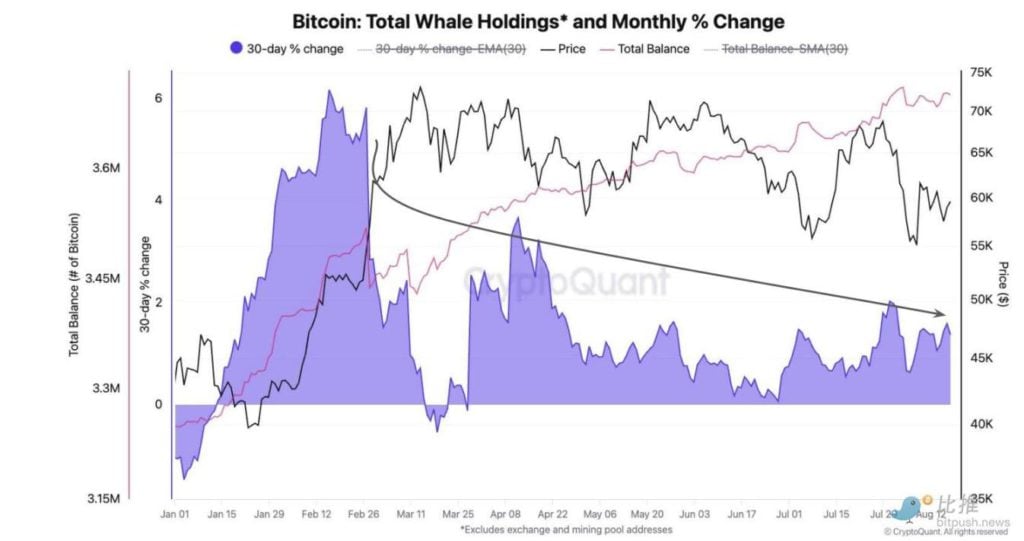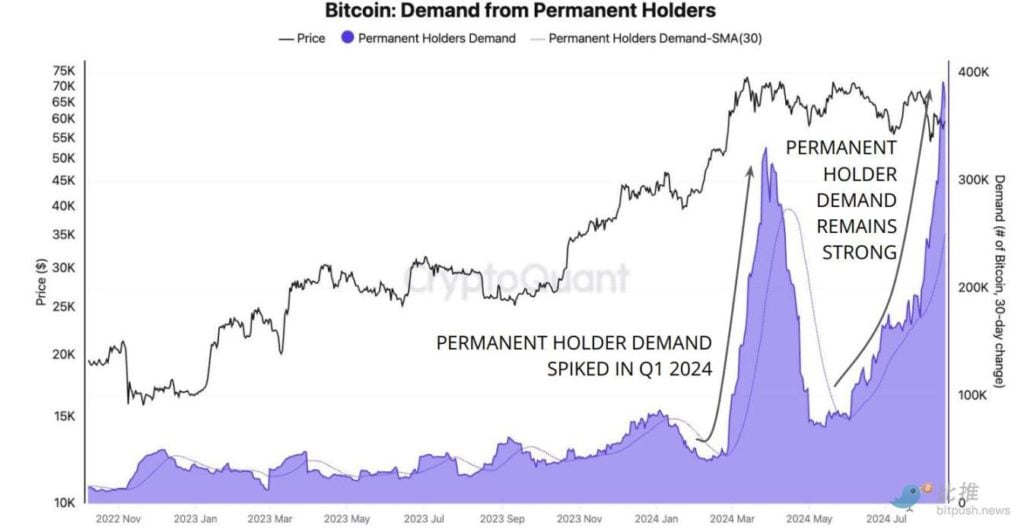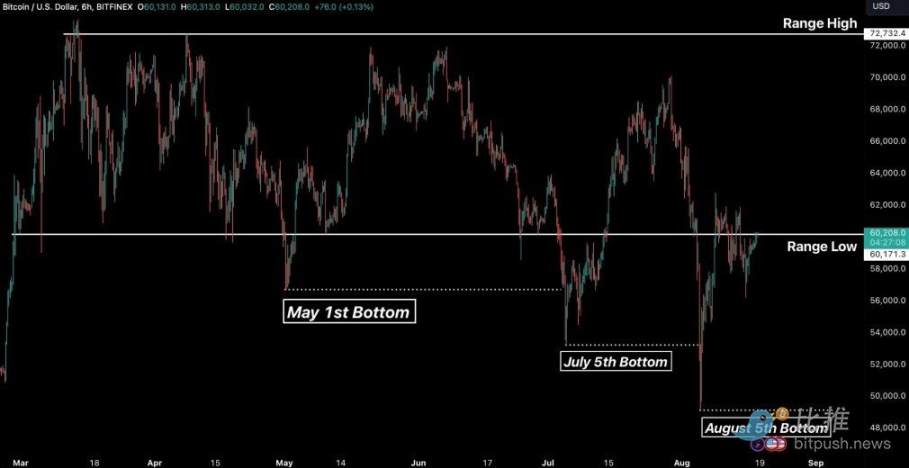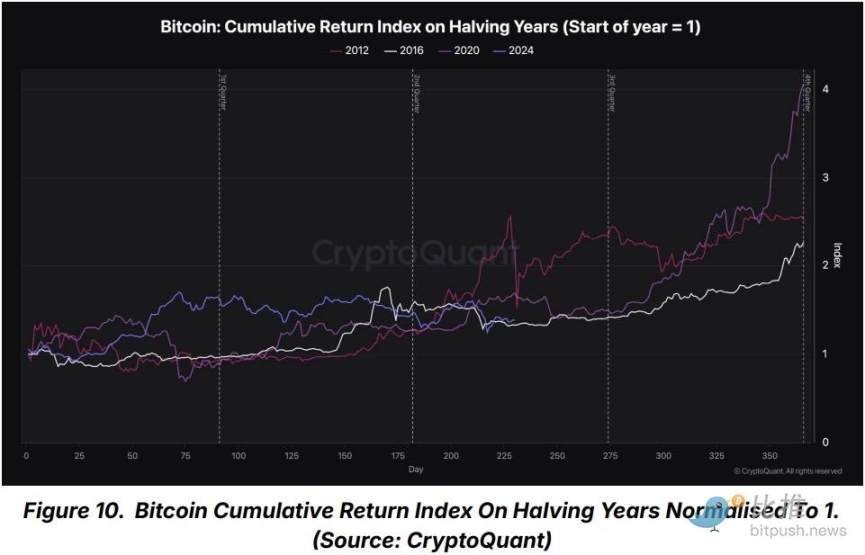There are no obvious market catalysts ahead of this week's annual gathering of global central banks in Jackson Hole. Bitcoin briefly surged above $61,000 in the early hours of Tuesday morning Eastern Time, but failed to continue to break through. At press time, Bitcoin was trading at $59,341.
Additionally, most of the top 200 Altcoin tokens by market capitalization saw gains. Meme coin Brett (BRETT) had the largest increase, rising 18%, followed by BitTorrent (BTT) and BinaryX (BNX), which rose 16.4% and 12.3% respectively.
Litecoin (LTC) was the biggest loser, down 3.3%, dYdX (DYDX) was down 3.2%, and MANTRA (OM) was down 2.6%. The current overall market value of cryptocurrency is US$2.11 trillion, and Bitcoin’s market share is 55.7%.
In U.S. stocks, the S&P 500 and Nasdaq fell 0.20% and 0.33% respectively at the close, while the Dow was flat.
Whale accumulation slows down
On-chain analytics firm CryptoQuant said that “most” demand indicators are currently showing weakness. CryptoQuant data shows that larger BTC holders (equivalent to whale) have significantly slowed down their currency accumulation since hitting a record high in March.
"The 30-day percentage change in whale holdings has declined from 6% in February (the fastest pace since February 2019) to 1% currently," the report shows. Growth rates above 3% are associated with rising Bitcoin prices, but that is not currently the case.”

However, one exception to the "summer slump" faced by the market are "permanent holders" - entities that only buy and never sell BTC.
The report states: “Despite the slowdown in overall Bitcoin demand growth, permanent holders continue to accumulate Bitcoin at unprecedented levels. The total balance of these holders is growing at a record rate of 391,000 Bitcoin per month. Demand from permanent holders is growing even faster than when the price of Bitcoin exceeded $70,000 in the first quarter of 2024.”

Analyst: The market is gradually recovering
Bitfinex analysts believe that the market is gradually recovering. After a large outflow of funds in early August, unlike the Ethereum ETF, the Bitcoin spot ETF saw a net inflow of $32.4 million last week, indicating that the interest of passive investors continues to exist, and the price of BTC has risen several times It broke above the range low around $60,000.

They said: “We did see some dip buying and profit taking in ETFs over the past week, with investors taking advantage of prices below $50,000 and then taking at least some of the profits. This is consistent with Ethereum. This is in sharp contrast to the Ethereum ETF, which still recorded net outflows this week despite the decline in the price of Ethereum being much greater than that of Bitcoin.”
The inflows into BlackRock's iShares Bitcoin ETF (IBIT) and Fidelity Bitcoin Fund (FBTC) are helping to protect against further downside losses, with what Bitfinex calls "passive" demand, a term they use to define demand that cannot be driven by prices. ETF inflows for systematic investing.”
Analysts said: “This difference in investment inflows into the Ethereum ETF reflects the broader market’s confidence in Bitcoin as an asset, despite the possible BTC supply from large holders such as the US government and Mt. Gox. Challenges like glut. The contrasting fortunes of the BTC and ETH ETFs highlight the different dynamics of the two markets, while the Ethereum ETF has struggled to maintain momentum as Grayscale’s ETH supply dries up. This is a turning point for the Ethereum ETF, but the next few months will be critical in determining whether demand can support this market.”
The report added: “It is also worth noting that BTC is currently trying to break out of the low of the four-month range. As such, we are at resistance and do not expect any explosive moves to follow due to the lack of any potential catalysts in the summer. Weakness and illiquidity remain widespread."
Bitfinex said that by examining Bitcoin's historical performance after halvings, the chart below "suggests that despite the recent decline, BTC is still following a similar trajectory to past bull markets and halving cycles."

They said: “These patterns suggest that the post-halving cycle is often characterized by a sharp rebound, even if it is preceded by a short-term decline. As of day 230 of the 2024 halving year (August 17), the year-to-date normalized return is 1.38 (38%).
They note: “At the same stage, after the 2016 and 2020 halvings, we had return ratios of 1.32 and 1.68 respectively; therefore, the current correction is not unusual, although the recent drop below $50,000 may be the traditional last resort after the halving. A correction, but we are still expected to follow the bull market trajectory of the past, with a possible final correction in the third quarter, consistent with the trajectory after the 2020 halving.”
Bitfinex analysts concluded: “It can be expected that illiquidity will continue over the summer. The broader economic environment, including the possibility of interest rate cuts by the US Federal Reserve, will also play an important role in shaping future ETF flows of BTC and ETH. Investment Investors should pay close attention to these developments as they can provide further insight into market movements."







